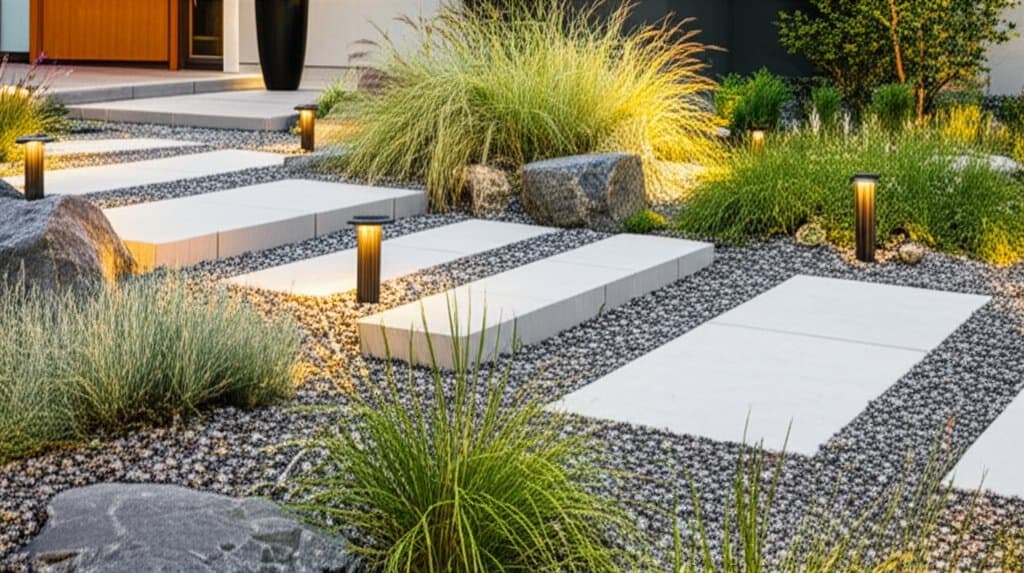Gravel Gardens: 2025's Smart Low-Maintenance Lawn Alternative
Imagine the morning sun reflecting off small, shimmering stones as a gentle breeze moves through clusters of lavender and sage. Birds sing in place of a lawnmower's drone, and gravel crunches softly underfoot. This scene captures the essence of a gravel garden, which exchanges water-hungry grass for layered textures, vibrant colors, and effortless tranquility. Homeowners seeking beauty without ongoing labor discover in gravel gardens a practical, eco-friendly option.
Challenges of Conventional Lawns
Conventional lawns appear verdant, yet they require steady supplies of water, fertilizer, and manual work. Homeowners often spend weekends on mowing, trimming edges, and combating weeds, which creates a repetitive burden. In areas with frequent droughts or nutrient-poor soil, sustaining grass demands significant effort. A gravel garden reverses this dynamic, delivering a landscape that flourishes with minimal intervention rather than constant care.
Benefits of Gravel Gardens in Low-Maintenance Design
- Water Conservation: Gravel preserves soil moisture and limits evaporation. Established plants typically demand irrigation only during prolonged dry spells.
- Weed Suppression: An appropriately installed gravel layer serves as a barrier, preventing weed seeds from germinating.
- Seasonal Resilience: Gravel gardens retain their allure across weather variations, unlike grass that withers under stress.
- Environmental Advantages: These gardens eliminate the need for synthetic fertilizers and reduce emissions from mowing equipment, supporting planetary health.
To amplify these benefits, select gravel in sizes from 1/4-inch pea gravel for smooth paths to 3/4-inch river rock for bolder contrasts. Pair with mulch alternatives like decomposed granite for added stability in high-traffic zones.
Steps to Build a Gravel Garden
Designing a gravel garden emphasizes harmony with nature over rigid precision. Select a sunny location to support drought-resistant species, and sketch a layout that incorporates curves and focal points for dynamic interest. Approach the project as composing a natural tableau with stones and vegetation.
Step 1: Site Preparation
Clear the area of grass, weeds, and debris using a sod cutter or manual tools. Level the soil to ensure even coverage, then install a geotextile fabric. This material suppresses weeds while permitting water infiltration, typically lasting several years before replacement.
Step 2: Gravel Selection and Installation
Choose gravel based on desired texture and functionality. Fine pea gravel suits gentle walkways, whereas angular decomposed granite compacts well for patios. Spread a 2- to 3-inch layer evenly, using a rake for uniform distribution. This depth balances aesthetics, drainage, and erosion control.
Step 3: Plant Selection for Durability
Focus on resilient, low-water plants adapted to gravelly conditions. Mediterranean varieties such as creeping thyme, upright rosemary, and silver-leafed sage offer scent and seasonal blooms. Incorporate feather reed grass for swaying height, or sedums and yarrow for low-growing color. Space plants 12 to 24 inches apart to allow maturation without overcrowding.
Step 4: Incorporating Structural Elements
Integrate larger rocks, such as limestone boulders or sculpted driftwood, to define zones and add depth. Position weathered ceramic pots for container accents, filled with cascading ice plant or agave. These features enhance visual rhythm and provide microhabitats for wildlife.
Strategies for Sustained Garden Health
Landscaping experts advise treating a gravel garden as a developing ecosystem. Permit plants to root deeply in the initial year by providing consistent moisture, then reduce watering to natural rainfall. Perform light maintenance, such as raking gravel paths quarterly and removing stray seedlings by hand, to preserve tidiness.
Enhance ecological value by including regional natives like black-eyed Susan or milkweed, which draw bees and butterflies. Monitor soil pH annually; gravel gardens often suit neutral to slightly alkaline conditions, where amendments like lime maintain plant vigor. This method transforms the space into a supportive refuge for local pollinators.
Experiencing a Gravel Garden Daily
As a gravel garden matures, it reveals subtle transformations tied to sunlight and weather. Dew glistens on stones at dawn, while dusk brings soothing shadows over foliage. Rainfall intensifies gravel hues and refreshes plant vitality, producing a dynamic visual array.
Practically, these gardens liberate time from routine chores. Skip the weekly mowing and automated sprinklers; reclaim those hours for relaxation amid a hardy, independent outdoor setting. The result fosters a deeper connection to nature through observation rather than intervention.
Implementing Your Gravel Garden Vision
Converting a lawn to gravel requires planning, yet delivers enduring rewards with modest input. Begin with a modest 10-by-10-foot section to test materials and techniques. Measure costs upfront: expect $2 to $5 per square foot for gravel, plus $20 to $50 per plant for starters.
Consult local guidelines for permeable surfaces to maximize stormwater benefits. As the garden expands, it embodies sustainable living principles. Through thoughtful assembly, your yard becomes a resilient tapestry of stone and growth, timeless in its peace and personal in its expression.




